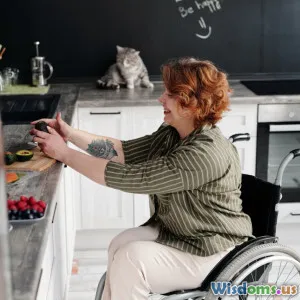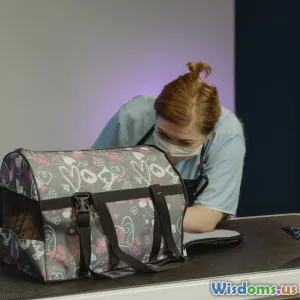
Art Therapy for Coping With the Death of a Pet
9 min read Explore how art therapy provides healing and comfort when facing the profound loss of a beloved pet. (0 Reviews)
Art Therapy for Coping With the Death of a Pet
Losing a pet can feel like losing a family member. Pets often anchor our daily lives with unconditional love, companionship, and comfort. When they pass away, the lingering grief can be overwhelming and uniquely difficult to navigate. Traditional conversations about loss can sometimes leave us wanting — especially when that loss isn’t human.
That’s where art therapy steps in. This creative approach taps into emotions beyond words and allows affected individuals to express, explore, and ultimately reconcile with their pain in healing ways.
In this in-depth article, we'll explore what art therapy involves, why it is effective for coping with pet loss, and how you can use it as a tool to mend the heart.
Understanding the Unique Grief of Losing a Pet
Bereavement for a pet can be profound. According to the American Veterinary Medical Association, approximately 67% of U.S. households own a pet — highlighting how common pet relationships are and the frequent interactions that lead to deep bonds. Dr. Susan Charney, a therapist who specializes in pet loss, notes that "Pet loss grief often gets minimized by others, making sufferers feel isolated in their mourning."
Pets offer nonjudgmental support and daily companionship; their absence is not just emotional but can create a disruption in daily routines and identity. Understanding the complexity of this grief is vital for effective coping strategies.
What is Art Therapy?
Art therapy is a form of expressive therapy that uses the creative process of art-making to improve and enhance the physical, mental, and emotional well-being of individuals. It harnesses the nonverbal communication power of art to express feelings that might be difficult to articulate.
Credited to pioneers like Margaret Naumburg and Edith Kramer, art therapy integrates psychological theory with artistic expression, often facilitated by licensed art therapists. Research published in the Journal of the American Art Therapy Association (2020) showed that individuals who engaged in art therapy felt notable reductions in anxiety and improved emotional well-being.
For those grieving a pet’s death, art therapy can open pathways to accessing raw feelings and fostering cathartic expression, enabling a journey through grief toward acceptance and peace.
Why Art Therapy is Effective for Pet Loss Grief
1. Facilitates Emotional Expression Beyond Words
Grief manifests in complex ways—sometimes as numbness, anger, or guilt. Art provides a channel for these emotions when words fall short. A study from the Art Therapy Journal (2018) documented how bereaved pet owners expressed sadness and joy simultaneously through painting sessions, helping them embrace their multifaceted emotions.
2. Creates a Tangible Memory of the Pet
Crafting visual or three-dimensional art forms allows mourners to create lasting tangible symbols of their pets. Whether it’s a portrait, a memory box, or a sculpture made from the pet’s collars and tags, these artifacts help keep cherished memories alive.
3. Promotes Mindfulness and Presence
Engaging in artistic creation requires focused attention, fostering mindfulness. Dr. Cathy Malchiodi, a leading art therapist, emphasizes that "the process of making art can ground individuals in the present moment, reducing anxieties tied to grief."
4. Encourages Community and Sharing
Group art therapy sessions create a supportive environment. Sharing personal art pieces and stories can validate one’s loss and reduce feelings of isolation.
Practical Art Therapy Techniques to Cope With Pet Loss
Journaling Through Visual Diaries
Keeping a visual diary involves daily or weekly sketches, collages, or drawings that capture memories, feelings, or moments connected to the pet. This consistent practice can reveal emotional trends and facilitate processing over time.
Memory Collage
Using photos, newspapers, fabric scraps, or dried flowers linked to your pet, build a collage that represents your pet’s life and your relationship. This tangible creation serves as a tribute and a focal point for reflection.
Painting or Drawing Emotions
Rather than aiming for realism, try abstract art to express emotions. Use colors and shapes to represent sadness, love, or acceptance. This process externalizes feelings, making them more manageable.
Creating a Pet Remembrance Box
Use decorative boxes to house cherished items like collars, toys, or other mementos. Decorate the box with paints, markers, or mixed media art to personalize it further.
Sculpture or Clay Modeling
Crafting a 3D form — whether it’s your pet’s likeness or a symbol of your bond — offers a tactile connection that can be profoundly comforting.
Real-World Examples and Success Stories
Emma, a 32-year-old artist, coped with her dog Max’s death by painting a large canvas series representing their life stages. She credits these paintings as "a way to speak to Max when words failed me." After completing the series, Emma joined a local art therapy group where she found additional support.
Another example comes from a community center that runs monthly art workshops for those dealing with pet loss. Participants report feeling "less alone" and find that art helps "unlock emotions buried beneath years of sorrow."
Integrating Art Therapy Into Your Grieving Process
- Start gently: You don’t need to be an artist. The key is expression, not perfection.
- Set aside time: Quiet, uninterrupted periods help immerse yourself in creative work.
- Create a supportive space: This may include ambient music, comforting scents, or cozy surroundings.
- Consider professional guidance: Licensed art therapists can tailor exercises to your emotional needs.
Beyond Individual Art Therapy: Pets and Memory Rituals
Complement art therapy with rituals like planting a tree in your pet’s honor or framing artwork created during your art therapy journey. The Bereavement Care Journal (2019) highlights that combining creative expression with ritual enhances closure.
Conclusion: Embracing Healing Through Creativity
The death of a pet marks a poignant chapter in life. While grief can feel isolating and overwhelming, art therapy offers a unique, healing pathway. It helps individuals articulate the ineffable sadness, celebrate the joy, and foster tangible connections to cherished memories.
By embarking on a therapeutic art process, you reclaim control over your grief journey, discover resilience, and transform heartache into lasting tribute. As Art Therapist Cathy Malchiodi insightfully states, "Art is not just about making something beautiful—it's about making something meaningful."
If you’re grappling with the loss of a pet, consider introducing art therapy into your healing process. Whether through solitary exploration or group facilitation, creative expression can illuminate a path toward peace and renewed hope.
Resources:
- American Art Therapy Association www.arttherapy.org
- Pet Loss Support Hotlines
- Books: The Art Therapy Sourcebook by Cathy Malchiodi
Rate the Post
User Reviews
Other posts in Mental Health
Popular Posts
















